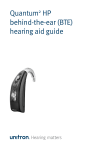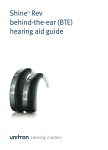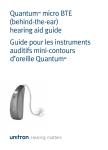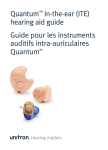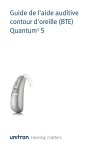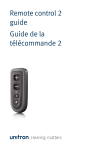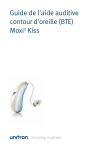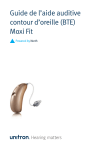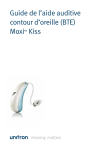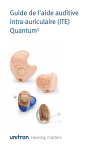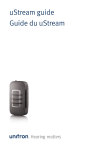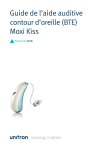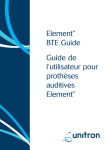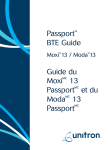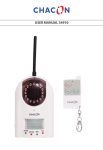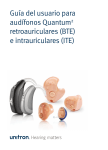Download PDF, 7 MB
Transcript
Quantum2 HP behind-the-ear (BTE) hearing aid guide Guide pour l’instrument auditif contour d’oreille Quantum2 HP Thank you Thank you for choosing Unitron hearing aids. At Unitron, we care deeply about people with hearing loss. We work closely with hearing healthcare professionals to make advanced, purpose-driven solutions available to everyone. Because hearing matters. Merci Merci d’avoir choisi les instruments auditifs d’Unitron. Chez Unitron, nous nous dévouons entièrement aux personnes souffrant de perte auditive. Nous travaillons en étroite collaboration avec des audioprothésistes afin de proposer des solutions de pointe, adaptées aux besoins de tous. Parce que l’audition, c’est essentiel. Your hearing aids Hearing healthcare professional:________________ ___________________________________________ Telephone:__________________________________ Model: _____________________________________ Serial number:_______________________________ Replacement batteries: Size 13 Warranty:___________________________________ Program 1 is for: _____________________________ Program 2 is for: _____________________________ Program 3 is for: _____________________________ Program 4 is for: _____________________________ Date of purchase: ____________________________ Quick reference Vos instruments auditifs Changing batteries Low battery warning 2 beeps every 30 minutes Plus (+) signs Professionnel de l'audition :____________________ ___________________________________________ Téléphone :__________________________________ 13 Modèle :____________________________________ On/Off Numéro de série : ____________________________ Piles de remplacement : On Off Open Lever v olume control; up=louder, down=softer SmartFocus™ 2 (comfort-clarity control); up=clarity, down=comfort Push button switching programs volume control; right aid=louder, left aid=softer SmartFocus 2 (comfort-clarity control); right aid=clarity, left aid=comfort Taille 13 Garantie :___________________________________ Le programme 1 correspond à :_________________ Le programme 2 correspond à :_________________ Le programme 3 correspond à :_________________ Le programme 4 correspond à :_________________ Date d'achat :________________________________ Aide-mémoire Table of contents Avertissement de pile faible Remplacement des piles 2 bips toutes les 30 minutes Signes plus (+) Your hearing aids at a glance...................................................... 4 Warnings..................................................................................... 6 Putting your hearing aids on your ears..................................... 10 Turning your hearing aids on and off .........................................12 Battery information....................................................................13 13 Tips for wearing hearing aids for the first time...........................17 Marche/Arrêt Tinnitus masker .........................................................................19 Operating instructions.............................................................. 22 Using the telephone.................................................................. 30 Protecting your hearing aids..................................................... 33 Cleaning your hearing aids........................................................ 34 Activé Désactivé Ouvert Levier Troubleshooting guide.............................................................. 42 contrôle du volume; haut=plus fort, bas=plus doux SmartFocus 2 (équilibre confort-clarté); haut=clarté, bas=confort MC Bouton Signature features of your hearing aids....................................38 Assistive listening devices........................................................40 changer de programme contrôle du volume; instrument droit= plus fort, instrument gauche=plus doux SmartFocus 2 (équilibre confort-clarté); instrument droit=clarté, instrument gauche=confort Information and explanation of symbols.................................. 47 Compliance information............................................................ 49 Patient feedback........................................................................51 Additional notes........................................................................ 52 Table des matières Aperçu de vos instruments auditifs.......................................... 54 Avertissements......................................................................... 56 Mise en place des instruments auditifs sur vos oreilles............61 Mise en marche et arrêt de vos instruments auditifs................ 63 Information sur la pile............................................................... 64 Conseils pour le port initial d'instruments auditifs..................68 Masqueur d'acouphènes.......................................................... 70 Instructions d'utilisation............................................................74 Utilisation du téléphone........................................................... 82 Protection de vos instruments auditifs..................................... 85 Nettoyage de vos instruments auditifs.....................................86 Caractéristiques distinctives de vos instruments auditifs....... 91 Aides de suppléance à l'audition.............................................. 94 Guide de dépannage.................................................................96 Information et explications sur les symboles..........................101 Déclaration de conformité...................................................... 103 Commentaires du client...........................................................105 Remarques supplémentaires.................................................. 106 Your hearing aids at a glance 1 Earhook - your custom made earmold attaches to your hearing aids using the earhook 9 D ome - holds the slim tube in place in your ear canal 2 Microphone - sound enters your hearing aids through the microphones. Microphone shield protects microphones from dirt & debris 10Retention piece - helps prevent the dome and slim tube from moving out of the ear canal 3 Push button - switches between listening programs or changes the volume level or SmartFocus 2, depending on your customized fitting 2 3 2 4 L ever - controls either the volume or SmartFocus 2, depending on your customized fitting 4 5 Battery door (on & off) - close the door to turn on your hearing aids, partly open the door to turn off your hearing aids. Opening the door all the way gives you access to change the battery 1 6 5 7 6 Tubing - part of the earmold that attaches it to the earhook 2 3 2 8 7 E armold - allows the sound to pass from the hearing aids to the ear and holds the hearing aids in place 4 8 Slim tube - sound travels down the slim tube to the ear canal 4 5 9 10 5 Warnings Hearing aids should only be used as directed by your physician or hearing healthcare professional. Hearing aids will not restore normal hearing and will not prevent or improve a hearing impairment resulting from organic conditions. Do not use your hearing aids in explosion hazard areas. Allergic reactions to hearing aids are unlikely. However, if you experience itching, redness, soreness, inflammation or a burning sensation in or around your ears, inform your hearing healthcare professional and contact your physician. In the unlikely case that any parts remain in the ear canal after the removal of the hearing aid, contact a physician immediately. Remove your hearing aids for CT and MRI scans or for other electromagnetic procedures. 6 Special care should be exercised in wearing hearing aids when maximum sound pressure levels exceed 132 decibels. There may be a risk of impairing your remaining hearing. Speak with your hearing healthcare professional to ensure the maximum output of your hearing aids is suitable for your particular hearing loss. Magnet warnings Be sure the magnet is securely affixed to the telephone. Keep loose magnets out of reach of children and pets. If the magnet falls into your ear, contact your hearing healthcare professional. If the magnet is swallowed, contact your physician immediately. The magnet may affect some medical devices or electronic systems. Always keep the magnet (or the telephone equipped with the magnet) at least 30 cm (12”) away from pacemakers, credit cards, floppy disks or other magnetically sensitive devices. 7 Too high distortion during dialing or phoning may mean that the phone handset is stressed by the magnet. To avoid any damage, please move the magnet to another place on the telephone receiver. Battery warnings Never leave hearing aids or batteries where small children and pets can reach them. Never put hearing aids or batteries in your mouth. If a hearing aid or battery is swallowed, call a physician immediately. Precautions The use of hearing aids is only part of hearing rehabilitation; auditory training and lip reading instruction may be required as well. In most cases, infrequent use of hearing aids does not provide full benefit. Once you have become accustomed to your hearing aids, wear your hearing aids everyday all day. 8 Your hearing aids use the most modern components to provide the best possible sound quality in every listening situation. However, communication devices such as digital cell phones can create interference (a buzzing sound) in hearing aids. If you experience interference from a cell phone being used close by, you can minimize this interference in a number of ways. Switch your hearing aids to another program, turn your head in a different direction or locate the cell phone and move away from it. Note to hearing healthcare professional Domes should never be fitted on patients with perforated eardrums, exposed middle ear cavities, or surgically altered ear canals. In the case of such a condition, we recommend to use a customized ear mold. Labeling The serial number and year of manufacture are located inside the battery door. 9 Putting your hearing aids on your ears 3.Place the hearing aid over the top of your ear. Your hearing aids may be color-coded with a small dot on the battery door: red = right ear; blue = left ear. Hearing aids with slim tubes Hearing aids with earmolds 1.Hold the earmold between 1. your thumb and index finger. The opening should be pointing in towards your ear canal with the hearing aid resting upwards above your ear. 2. 2.Carefully insert the earmold in your ear. You may need to twist it slightly to the back. The earmold should fit 3. into your ear snugly and comfortably. Gently pull down and back on your earlobe to help you insert the earmold into your ear canal more easily. 10 1.Place the hearing aid over 1. the top of your ear. The slim tube should lie flush against your head and not stick out. 2.Hold the slim tube where it attaches to the dome and 2. gently push the dome into your ear canal. 3.Place the retention piece in your ear so it rests at the bottom of the opening of 3. your ear canal. 11 Turning your hearing aids on and off Battery information Your hearing aids have a three-position battery door that acts as an on/off switch and that allows access to the battery compartment. 1. On: Close the battery door 1. fully. To replace the battery, fully open the battery door for access to the battery compartment. Note: It may take 5 seconds before the hearing aid turns on. Your hearing healthcare provider can increase the start up delay if required. 2. O ff: Partially open the battery door. 3. Open: Fully open the battery door to access and change the battery. 12 Note: When turning your hearing aid on and off while it is on the ear, grasp the top and bottom of the hearing aid with your index finger and thumb. Use the index finger of your opposite hand to open and close the battery door. 2. 3. Low battery warning Two long beeps indicate the hearing aid battery is low. After the low battery warning, sounds may not be as clear. This is normal and can be fixed by changing the batteries in the hearing aids. If you are not able to hear the low battery warning, your hearing healthcare professional can change its pitch or loudness. If you prefer, it can be turned off entirely. Your hearing aids are designed to generate a low battery warning every 30 minutes until you change the batteries, but depending on the condition of the batteries, they may die before another low battery warning occurs. Therefore, it is recommended that the batteries are replaced as soon as possible once you hear the low battery warning. 13 Replacing the battery 1.Gently swing out the battery door with your fingernail. 2.Grasp the battery with your thumb and index finger and remove. 3.Insert the new battery into the battery compartment with the plus (+) sign on the battery facing the same way as the plus (+) sign on the side of the battery door. This will ensure that the battery door closes properly. Note: If the battery is inserted incorrectly, the hearing aid will not turn on. 1. 2. 3. 4. Replacing the battery in hearing aids with a tamper-resistant battery door Some hearing aids have a tamper- 1. resistant battery door for safety reasons. To replace the battery, open the battery compartment and push the locking piece back 2. inside the hearing aid using the tip of a pen. Remove the old battery. Insert a new one with the plus (+) sign on the battery facing the same way as the plus (+) sign on the side of 3. the battery door. The new battery will be secured when you close the battery door. 4. Close the battery door. 14 15 Caring for batteries Always discard batteries in a safe and environmentally friendly way. To prolong battery life, remember to turn your hearing aids off when not in use, especially when asleep. Remove the batteries and keep the battery door open while hearing aids are not being worn, especially when asleep. This will allow internal moisture to evaporate. Tips for wearing hearing aids for the first time • Start in a quiet room at home first to get • • • • 16 used to the new sound quality. Sounds like the ticking of a clock, the humming of the computer, the beep of the microwave or the rustling of clothes or paper may seem loud to you at first, because you have not been hearing them properly for a long time. Read aloud to yourself and learn to adjust the volume of your own voice when you are wearing the hearing aids. Talk to different people and learn how to distinguish between different sound patterns again. It will take some time before you are completely used to your hearing aids and can fully enjoy the benefits. Wear your hearing aids for as many hours a day as you can, and for a little longer each day. 17 • Make notes at the back of this booklet, write down difficult situations and describe what any unpleasant noises were like. This information will help your hearing healthcare professional to fine-tune the hearing aids better for your needs. • Involve your family and friends in this familiarization period. For example, ask someone to set the television to a comfortable volume. • When you are beginning to get used to wearing the hearing aids, wear them in more difficult listening environments such as the office, at parties or in restaurants. This can be difficult even for people who can hear normally. Give yourself time to regain your ability to hear in these difficult situations. • Make your hearing aids part of your everyday life and be patient with yourself while you are learning to hear sounds correctly. 18 Tinnitus masker Unitron’s tinnitus masker is a broadband sound generator available on the Unitron Era™ hearing aid platform. It provides a means of sound enrichment therapy that can be used as part of a personalized tinnitus management program to provide temporary relief from tinnitus. The underlying principle of sound enrichment is to provide supplementary noise stimulation which can help defocus your attention from your tinnitus and avoid negative reactions. Sound enrichment, coupled with instructional counseling, is an established approach to managing tinnitus. Tinnitus masker warnings Air conduction hearing aids with Unitron’s tinnitus masker are to be fitted by a hearing healthcare professional familiar with the diagnosis and management of tinnitus. 19 Should you develop any side effects while using Unitron’s tinnitus masker, you should discontinue use of the device and seek a medical evaluation. Side effects include headaches, nausea, dizziness, heart palpitations or decrease in auditory function (such as decreased tolerance to loudness, speech not as clear or worsening of tinnitus). The volume of Unitron’s tinnitus masker can be set to a level which could lead to permanent hearing damage when used for a prolonged period of time. Should the tinnitus masker be set to such a level in your hearing aid, your hearing healthcare professional will advise you of the maximum amount of time per day you should use the tinnitus masker. The tinnitus masker should never be used at uncomfortable levels. 20 Important information Unitron’s tinnitus masker generates sounds that are used as part of your personalized tinnitus management program to provide temporary relief from tinnitus. It should always be used as prescribed by a hearing healthcare professional who is familiar with the diagnosis and treatment of tinnitus. Good health practice requires that a person reporting tinnitus have a medical evaluation by a licensed ear physician before using a sound generator. The purpose of such an evaluation is to ensure that medically treatable conditions, which may be causing tinnitus, are identified and treated prior to using a sound generator. Unitron’s tinnitus masker is intended for adults 18 years of age or older who have both hearing loss and tinnitus. 21 Operating instructions SmartFocus 2 (comfort-clarity control) Your hearing aids come with two controls that allow you to further adjust them – a lever and a push button. Lever The lever on your hearing aids can be set up as either a volume control or a SmartFocus 2 control. Volume control If the lever has been configured as a volume control: • Press up to increase volume. • Press down to decrease volume. As you change the volume level, your hearing aids will beep. Volume setting Suggested volume level Beeps 1 beep Turning volume up short beep Turning volume down short beep Maximum volume level 2 beeps Minimum volume level 2 beeps 22 If the lever has been configured as a SmartFocus 2 control: • Press up to increase clarity of speech. • Press down to decrease overall noise or improve listening comfort. Each step will change the hearing aid performance. Sometimes multiple steps are required to achieve the desired listening results. After each press wait for about 4-5 seconds to allow the hearing aid to adjust to the new setting. As you change the SmartFocus 2 level, your hearing aids will beep. For more information or details, please see page 38. 23 SmartFocus 2 setting Ideal comfort and clarity level Beeps 1 beep Increase sound clarity level short beep Increase listening comfort short beep Maximum sound clarity level 2 beeps Maximum listening comfort level 2 beeps Tamper-resistant cover Some hearing aids are fitted with tamper-resistant covers instead of levers to prevent someone from accidentally adjusting the hearing aids. The cover can still be used to make adjustments but it requires using a fingernail or a small tool to push up or down. Push button Your hearing aids are equipped with a push button which can be set for switching between programs, to adjust your volume or adjust SmartFocus 2. Program control If the push button has been configured as a program control, each time you push the button, you will move to a new hearing aid program. Your hearing aids beep to indicate which program you are in. Program 1 (e.g. Automatic Program) Program 2 (e.g. speech in noise) 1 beep Program 3 (e.g. easy-t/telephone) 3 beeps Program 4 (e.g. music) 4 beeps Easy-t/telephone (see pg 30) short melody Easy-DAI (see pg 40) short melody DuoLink (if enabled) (see pg 28) 2 beeps Opposite ear beeps the same as side being adjusted Please see the front of this booklet for a listing of your personalized programs. 24 25 Volume control If your push button has been configured as a volume control: • Push the button on your right hearing aid to increase the volume in both hearing aids. • Push the button on your left hearing aid to decrease the volume in both hearing aids. Volume setting Suggested volume level Beeps 1 beep Turning volume up short beep Turning volume down short beep Maximum volume level 2 beeps Minimum volume level 2 beeps SmartFocus 2 (comfort-clarity control) If the push button has been configured as a SmartFocus 2 control: • Push the button on your right hearing aid to increase clarity of speech. • Push the button on your left hearing aid to decrease overall noise or improve listening comfort. 26 Each step will change the hearing aid performance. Sometimes multiple steps are required to achieve the desired listening results. After each press wait for about 4-5 seconds to allow the hearing aid to adjust to the new setting. As you change the SmarFocus 2 level, your hearing aids will beep. For more information or details, please see page 38. SmartFocus 2 setting Ideal comfort and clarity level Increase sound clarity level Beeps 1 beep short beep Increase listening comfort short beep Maximum sound clarity level 2 beeps Maximum listening comfort level 2 beeps 27 Tinnitus masker If your hearing healthcare professional has configured both a tinnitus masker program and a volume control, you can adjust the tinnitus masker level while you are in the tinnitus masker program. To adjust the noise level: • Press + to increase • Press – to decrease As you change the level, your hearing aids will beep. For more information or details, please see page 19. DuoLink If DuoLink is enabled, then changing the volume, program or SmartFocus 2 setting on one hearing aid, will automatically make the change to both hearing aids at the same time. DuoLink works for both the push button and the lever. For example, if your push button is configured as a program control and DuoLink is enabled, 28 when you push the button on your right hearing aid, the program will change on both hearing aids. Learning Over time, the hearing aid will record your preferred settings and change the start up position on your volume or SmartFocus 2 within the range that the hearing healthcare professional has given you access to, if they have enabled this feature. For example, if the hearing healthcare professional has given your volume control 5 steps down and 5 steps up, and you use it always at 3 steps down, the hearing aid will learn this over time and place your start up position at 3 steps down. The learning feature does not apply to tinnitus masker settings. Remote control Your hearing aids may also come with an optional remote control which allows you to switch between different listening programs, and change your volume or SmartFocus 2 settings. 29 Using the telephone As telephones do not all work the same, you may experience different results from different phones. You can use many phones by simply holding the receiver to your ear, without the need to change to a dedicated telephone program on your hearing aid. You may need to move the handset slightly up or back to find the position that sounds best to you. Depending on the phone type you use, your hearing healthcare professional might have selected a dedicated phone program on your hearing aids. Your hearing aids may have an automatic telephone program (easy-t feature), which automatically switches to a dedicated telephone program when a telephone receiver is brought close to one of your hearing aids. You will hear a short melody to indicate you are in the telephone (easy-t) program. 30 When the receiver is moved away from the hearing aid, it will automatically return to the previous listening program. If the hearing aid does not switch to the telephone program automatically when the telephone receiver is held to the ear, the magnet for easy-t hearing aids should be attached to the telephone receiver. The magnet is designed to strengthen the magnetic field at the ear piece of hearing aid compatible telephones. To affix the optional magnet: 1. Clean the telephone receiver. 1. Hold the magnet near the “listening end” of your telephone receiver and release it. The magnet will flip to the 2. appropriate side and seek the optimal position on the telephone receiver. 2. Place the double-sided tape 3. in this optimal position on the telephone receiver. 3. Attach the magnet to the tape. 31 Your hearing healthcare professional may also have set up a phone program that you can access through the push button on your hearing aids, or through your optional remote control. If your hearing aids are configured to work with the wireless uDirect™ 2 neck worn accessory, you might benefit from a Bluetooth® hands free option. Refer to the uDirect 2 user guide for more information. The Binaural Phone feature enables you to hold a phone to one ear and hear the sound clearly in both ears. No accessories are required. Protecting your hearing aids • Open the battery door when not in use. • Always remove your hearing aids when • • ® Bluetooth is a registered trademark of Bluetooth SIG Inc. • • • 32 using hair care products. The hearing aids can become clogged and cease to function properly. Do not wear your hearing aids in the bath or shower or immerse them in water. If your hearing aids do become wet, do not attempt to dry them in an oven or microwave. Do not adjust any controls. Open the battery doors immediately, and allow your hearing aids to dry naturally for 24 hours. Protect your hearing aids from excessive heat (hair dryer, vehicle glove box or dashboard). Regular use of a dehumidifier, such as a Dri-Aid kit, can help prevent corrosion and prolong the life of your hearing aids. Do not drop your hearing aids or knock them against hard surfaces. 33 Cleaning your hearing aids Use a soft cloth to clean your hearing aid at the end of each day, and place it in its case with the battery door open to allow moisture to evaporate. Ear wax is natural and common. Ensuring your hearing aids are free of ear wax is an important step in your daily cleaning and maintenance routine. Never use alcohol to clean your hearing aids, earmolds or domes. Do not use sharp tools to dislodge ear wax. Sticking household items into your hearing aids or earmolds can seriously damage them. Cleaning your earmolds Clean the earmold and the outside of the earhook with a damp cloth at the end of each day. Do not use alcohol to clean your earmolds. If the earmolds become plugged, clear the opening with a wax loop or pipe cleaner. 34 If your physician prescribes eardrops, clean any moisture that may get into the earmolds or tubing to prevent plugging. If the earmolds require further cleaning: 1.Disconnect the plastic tube from the hook of the hearing aid, by holding the hearing aid in one hand and gently pulling the tubing away from the earhook. 2.Wash only the earmolds and tubing in warm water with a mild soap. 3.Rinse them with cool water and dry overnight. 4.Make sure the earmold tubes are completely dry. Reconnect them to the earhook on your hearing aid by sliding the tubing back on to the earhook. Use of a hearing aid blower can assist with removing moisture/debris from the tube. See your hearing healthcare professional for more information. 35 Cleaning your slim tubes and domes You should have the slim tubes and domes replaced by your hearing healthcare professional approximately every three to six months or when they become stiff, brittle, or discolored. Clean the outside of the domes at the end of each day with a damp cloth. You should also clean the slim tubes periodically, with the cleaning pin provided, when you begin to notice debris in and around the tubes. 1. Hold the slim tube in one hand and the hearing aid in the other hand. 2. Gently turn the hearing aid until it detaches from the slim tube. 3. Use a damp cloth to clean the outside of the slim tube and dome. 4. Remove the dome from the slim tube by pulling gently, before cleaning the slim tube. 36 5. Using the black cleaning pin provided in the kit, gently insert the cleaning pin where the slim tube attaches to the hearing aid and push the pin all the way through the tube. Note: The slim tubes and domes should never be rinsed or submerged in water as water drops may become lodged in the tube, block sound or damage the electrical components of the hearing aid. 6. Once the slim tube has been cleaned, reattach it by gently turning the hearing aid onto the slim tube. 7.Reattach the dome to the slim tube by gently pushing it back onto the threading at the end of the tube. You will feel the dome click onto the ridges of the slim tube, and you won’t be able to push it any further. 37 Signature features of your hearing aids SmartFocus 2 (comfort-clarity control) Your hearing aids automatically adjust to focus on hearing speech more clearly or to provide comfort in noisy situations. Some hearing aid models have either a control and/or a remote to adjust SmartFocus 2 settings. • Adjusting SmartFocus 2 up causes your hearing aids to focus more on speech clarity. • Adjusting SmartFocus 2 down causes your hearing aids to soften background noise, providing more comfort. Please talk with your hearing healthcare professional to find out which controls have been programmed for SmartFocus 2. As you adjust SmartFocus 2, your hearing aids will gradually learn your preferred SmartFocus 2 settings. Binaural Phone a phone to one ear and hear the sound clearly in both ears. No accessories are required. uDirect 2 and uTV 2 The uDirect 2 and uTV™ 2 are optional accessories for your hearing aids. • uDirect 2 provides easy, hands-free access to Bluetooth enabled devices, such as mobile phones. It also has a wired audio jack to plug in devices like MP3 players, and can provide remote control functions to adjust your hearing aids for increased listening comfort. • uTV 2 is used with the uDirect 2 to send sound from your TV directly to your hearing aids. The uTV 2 can also transmit sound from stereo systems, computers and other audio sources. For more information on using the uDirect 2 or uTV 2, please see the user guide for that accessory. For information on how to get a uDirect 2 or uTV 2 accessory, please contact your hearing healthcare professional. The Binaural Phone feature enables you to hold 38 39 Assistive listening devices Listening in public places Telecoils pick up electromagnetic energy and convert it into sound. Your hearing aid’s telecoil option can help you listen in public places equipped with telecoil compatible assistive listening devices such as a loop system. When you see this symbol, it means that there is a loop system installed; this loop system is compatible with your hearing aid. Please contact your hearing healthcare professional for more information on loop systems. audio input program when a DAI signal is detected by your hearing aids. A short melody will play to confirm that easy-DAI is activated. When you disconnect the DAI input, your hearing aids will return to the program you were in prior to switching. Ask your hearing healthcare professional for information about the direct audio input system and a connector cord. Connecting to external audio sources Your hearing aids may feature an optional direct audio input (DAI) to connect to other audio sources, such as a stereo or television, using an FM system or a cable. The uDirect 2, an optional wireless accessory, also has a DAI jack. Easy-DAI automatically selects your direct 40 41 Troubleshooting guide Cause Possible remedy No sound Not turned on Replace battery Poor battery contact Consult your hearing healthcare professional Battery upside down Insert battery plus (+) side up Earmolds/slim tubes/ domes blocked with ear wax Clean earmolds/ domes. See “Cleaning your hearing aids.” Use cleaning pin to dislodge ear wax in slim tubes. Consult your hearing healthcare professional 42 Consult your hearing healthcare professional Possible remedy Not loud enough Low volume Turn up volume; see hearing healthcare professional for models without a manual volume control or if problem persists Low battery Replace battery Earmolds/slim tubes/ domes not inserted properly See “Putting your hearing aids on your ears.” Remove and reinsert carefully Change in hearing Consult your hearing healthcare professional Earmolds/slim tubes/ domes blocked with ear wax Clean earmolds. See “Cleaning your hearing aids.” Use cleaning pin to dislodge ear wax in slim tubes. Consult your hearing healthcare professional Plugged microphone shield Consult your hearing healthcare professional Turn on Low/dead battery Plugged microphone shield Cause 43 Cause Possible remedy Possible remedy Not clear, distorted Intermittent Low battery Replace battery Dirty battery contact Consult your hearing healthcare professional Two long beeps Low battery Cause Poorly fitting earmolds/ slim tubes/domes Consult your hearing healthcare professional Earmolds/slim tubes/ domes blocked with ear wax Clean earmolds. See “Cleaning your hearing aids.” Use cleaning pin to dislodge ear wax in slim tubes. Consult your hearing healthcare professional Low battery Replace battery Consult your hearing healthcare professional Replace battery Whistling Earmolds/slim tubes/ domes not inserted properly See “Putting your hearing aids on your ears.” Remove and reinsert carefully Plugged microphone shield Hand/clothing near ear Move hand/clothing away from your ear Earmolds/slim tubes/domes falling out of ear Poorly fitting earmolds/ slim tubes/domes Consult your hearing healthcare professional 44 Poorly fitting earmolds/ slim tubes/domes Consult your hearing healthcare professional Earmolds/slim tubes/ domes not inserted properly See “Putting your hearing aids on your ears.” Remove and reinsert carefully 45 Cause Possible remedy Information and explanation of symbols Weak on the telephone Telephone not positioned properly Move telephone receiver around ear for clearer signal. See “Using the telephone” Hearing aid requires adjustment Consult your hearing healthcare professional For any problems not listed in the guide, contact your hearing healthcare professional. xxxx The CE symbol is a confirmation by Unitron that this Unitron product meets the requirements of the R&TTE Directive 1999/5/EC on Radio and Telecommunication Terminal Equipment. The numbers after the CE symbol are the numbers of the consulted certified bodies under the above mentioned directives. This symbol indicates that it is important for the user to read and take into account the relevant information in this user guide. This symbol indicates that it is important for the user to pay attention to the relevant warning notices in this user guide. Important information for handling and product safety. Australian EMC and Radiocommunications compliance label. This symbol indicates that the products described in these user instructions adhere to the requirements for an application part of Type B of EN 60601-1. The surface of the hearing aid is specified as applicated part of Type B. 46 47 Operating conditions: This device is designed such that it functions without problems or restrictions if used as intended, unless otherwise noted in these user guides. 0° to 55° Celsius and relative humidity of <95% (non condensing). Transport and storage conditions: Temperature: –20° to +60° Celsius (–4° to +140° Fahrenheit). Humidity Transportation: Up to 90% (non condensing). Humidity Storage: 0% to 70%, if not in use. Atmospheric pressure: 200 hPA to 1500 hPa. The symbol with the crossed-out garbage bin is to make you aware that this device may not be thrown away as normal household waste. Please dispose of old or unused devices, at waste disposal sites intended for electronic waste, or give your device to your hearing healthcare professional for disposal. Proper disposal protects the environment and health. The Bluetooth® word mark and logos are registered trademarks owned by Bluetooth SIG, Inc. and any use of such marks by Unitron is under license. Other trademarks and trade names are those of their respective owners. Quantum2 Quantum2 is a trademark of Unitron. 48 Compliance information Declaration of conformity Hereby Unitron declares that this Unitron product meets the requirements of the Medical Devices Directive 93/42/EEC as well as the Radio and Telecommunications Terminal Equipment Directive 1999/5/EC. The full text of the Declaration of Conformity can be obtained from the manufacturer. The hearing aid described in this user guide is certified under: Standard hearing system USA Canada FCC ID: VMY-UWBTE1 IC: 2756A-UWBTE1 Notice 1 This device complies with Part 15 of the FCC Rules and with RSS210 of Industry Canada. Operation is subject to the following two conditions: 1) this device may not cause harmful interference, and 2) this device must accept any interference received, including interference that may cause undesired operation. Notice 2 Changes or modifications made to this device not expressly approved by Unitron may void the FCC authorization to operate this device. 49 Notice 3 This device has been tested and found to comply with the limits for a Class B digital device, pursuant to Part 15 of the FCC Rules and ICES-003 of Industry Canada. These limits are designed to provide reasonable protection against harmful interference in a residential installation. This device generates, uses and can radiate radio frequency energy and, if not installed and used in accordance with the instructions, may cause harmful interference to radio communications. However, there is no guarantee that interference will not occur in a particular installation. If this device does cause harmful interference to radio or television reception, which can be determined by turning the equipment off and on, the user is encouraged to try to correct the interference by one or more of the following measures: Patient feedback Record your specific needs or concerns and bring to your first office visit after getting your hearing aids. This will help your hearing healthcare professional to address your needs. _________________________________________ _________________________________________ • Reorient or relocate the receiving antenna _________________________________________ • Increase the separation between the equipment and receiver _________________________________________ • C onnect the device into an outlet on a circuit different from that to which the receiver is connected • C onsult the dealer or an experienced radio/TV technician for help _________________________________________ _________________________________________ _________________________________________ _________________________________________ _________________________________________ _________________________________________ 50 51 Additional notes ___________________________________________ ___________________________________________ ___________________________________________ ___________________________________________ ___________________________________________ ___________________________________________ ___________________________________________ ___________________________________________ ___________________________________________ ___________________________________________ ___________________________________________ 52 53 Aperçu de vos instruments auditifs 1 Coude auriculaire - vos embouts auriculaires sur mesure sont raccordés à vos instruments auditifs par le coude auriculaire 2 Microphone - le son entre dans vos instruments auditifs par l'intermédiaire des microphones. Protège-microphone - protège les microphones de la saleté et des résidus 3 Bouton - permet de passer d'un programme d'écoute à un autre ou de changer le niveau de volume ou de confort/clarté, selon vos réglages personnalisés 4 Levier - permet de régler le volume ou le SmartFocus 2, selon vos réglages personnalisés 5 Couvercle du compartiment à pile/mise en marche et arrêt - fermez le couvercle pour mettre vos instruments auditifs en marche, ouvrez partiellement le couvercle pour les arrêter. L'ouverture complète du couvercle vous permet d'accéder à la pile pour la remplacer 6 Tube - partie de l'embout auriculaire qui se raccorde au coude auriculaire 7 Embout auriculaire - permet aux sons de passer des instruments auditifs aux oreilles et maintient les instruments auditifs en place 54 8 Tube fin - le son voyage le long du tube fin vers le canal auditif 9 Dôme - maintient le tube fin en place dans votre conduit auditif 10Pièce de rétention - aide à empêcher le dôme et le tube fin de sortir du conduit auditif 2 3 2 1 6 4 5 7 2 3 2 8 4 5 9 55 10 Avertissements 56 Les instruments auditifs doivent être uniquement utilisés conformément aux instructions de votre médecin ou audioprothésiste. Les instruments auditifs ne rétabliront pas l'audition normale et ne préviendront, ni n’amélioreront, une perte auditive due à des conditions organiques. Vos instruments auditifs ne doivent pas être utilisés dans des zones présentant un danger d'explosion. Les réactions allergiques aux instruments auditifs sont peu probables. Cependant, en cas de démangeaison, de rougeur, de douleur, d'inflammation ou de sensation de brûlure à l'intérieur ou autour des oreilles, informez votre audioprothésiste et communiquez avec votre médecin. Dans l'éventualité improbable où des pièces resteraient dans votre conduit auditif après le retrait de l'instrument auditif, contactez immédiatement un médecin. Retirez vos instruments auditifs pour les scanographies, examens par IRM ou autres procédures électromagnétiques. Faites extrêmement attention lorsque vous portez vos instruments auditifs dans un endroit où le niveau de pression sonore maximal dépasse 132 décibels. Vous pourriez affecter votre audition. Communiquez avec votre audioprothésiste pour vous assurer que le niveau de sortie maximal de vos instruments auditifs convient à votre perte auditive. Avertissements concernant l'aimant Vérifiez que l'aimant est bien fixé sur le téléphone. Gardez les aimants non installés hors de portée des enfants et des animaux. Si l'aimant tombe dans votre oreille, communiquez avec votre audioprothésiste. Si l'aimant est ingéré, communiquez immédiatement avec votre médecin. 57 L'aimant peut affecter certains dispositifs médicaux ou systèmes électroniques. Maintenez toujours l'aimant (ou le téléphone équipé de l'aimant) à une distance d'au moins 30 cm des stimulateurs cardiaques, des cartes de crédit, des disquettes ou de tout autre dispositif sensible aux champs magnétiques. Une trop grande distorsion, lorsque vous composez un numéro ou que vous téléphonez, peut signifier que l'aimant affecte le fonctionnement du combiné téléphonique. Pour éviter tout dommage, veuillez placer l'aimant à un autre endroit du récepteur téléphonique. Avertissements concernant la pile Ne laissez jamais les instruments auditifs ou les piles à la portée de jeunes enfants ou d'animaux. Ne mettez jamais les instruments auditifs ou les piles dans votre bouche. Si un instrument auditif ou une pile est ingéré, appelez immédiatement un médecin. 58 Précautions L'utilisation d'instruments auditifs ne constitue qu'un aspect de la rééducation auditive; l'entrainement auditif et l'apprentissage de la lecture labiale peuvent aussi être nécessaires. Dans la plupart des cas, une utilisation irrégulière des instruments auditifs ne permet pas de tirer pleinement avantage de ceux-ci. Une fois que vous êtes habitué à vos instruments auditifs, portez-les tous les jours et toute la journée. Vos instruments auditifs utilisent les composants les plus récents pour vous offrir la meilleure qualité sonore, quel que soit votre environnement d'écoute. Cependant, des instruments de communication, comme les téléphones cellulaires numériques, peuvent créer des interférences (bourdonnement) avec vos instruments auditifs. Si vous constatez la présence d'interférences liées à la proximité d'un téléphone cellulaire, vous pouvez minimiser 59 celles-ci de différentes manières : changer le programme de vos instruments auditifs, tourner la tête dans une autre direction ou repérer le téléphone cellulaire pour vous en éloigner. Remarque destinée à l'audioprothésiste Il ne faut jamais installer de dôme sur des clients avec des tympans perforés, des caisses de tympan exposées ou des conduits auditifs altérés par chirurgie. Dans le cas de telles affections, nous conseillons d'utiliser un embout auriculaire sur mesure. Identification Le numéro de série et l'année de fabrication sont indiqués sur l'intérieur du couvercle du compartiment à pile. Mise en place des instruments auditifs sur vos oreilles Vos instruments auditifs peuvent comporter un code couleur sous la forme d'un petit point visible à l’ouverture du compartiment à pile : rouge = oreille droite; bleu = oreille gauche. 1. Instruments auditifs avec embouts auriculaires 1.Saisissez l'embout auriculaire entre le pouce et l'index. L'ouverture doit être orientée vers 2. votre conduit auditif, l'instrument auditif reposant sur le haut de votre oreille. 2.Insérez doucement l'embout auriculaire 3. dans votre oreille. Vous devrez peut-être le tourner légèrement vers l'arrière. L'embout auriculaire doit 61 être agréable à porter et bien ajusté à votre oreille. Tirez délicatement votre lobe d'oreille vers le bas et vers l'arrière pour vous aider à insérer plus facilement l'embout auriculaire dans votre conduit auditif. 3.Placez l'instrument auditif sur le dessus de votre oreille. Instruments auditifs avec tubes fins 1. 1.Placez l'instrument auditif sur le dessus de votre oreille. Le tube fin doit affleurer l’oreille et ne pas dépasser. 2. 2.Tenez le tube fin au niveau de son point d'attache avec le dôme et poussez doucement ce dernier à l'intérieur du conduit auditif. 3.Placez la pièce de rétention 3. dans votre oreille de façon à ce qu'elle repose au bas de l'ouverture de votre conduit auditif. 62 Mise en marche et arrêt de vos instruments auditifs Vos instruments auditifs possèdent un couvercle de compartiment à pile à trois positions qui agit comme un interrupteur marche/arrêt et permet l'accès au compartiment à pile. 1. 1. Marche : fermez complètement le couvercle du compartiment à pile. Remarque : L'instrument auditif peut prendre 5 secondes à 2. se mettre en marche. Votre audioprothésiste peut augmenter le délai de mise en marche si cela est nécessaire. 2. Arrêt : ouvrez partiellement le couvercle du compartiment à 3. pile. 3. Ouvert : ouvrez complètement le couvercle du compartiment à pile pour accéder à la pile et la remplacer. 63 Remarque : Pour mettre en marche ou arrêter votre instrument auditif lorsque vous le portez, saisissez le haut et le bas de l'instrument auditif entre l'index et le pouce. Ouvrez et fermez le couvercle du compartiment à pile à l'aide de l'index de votre autre main. Information sur la pile Pour remplacer la pile, ouvrez complètement le couvercle de façon à accéder au compartiment à pile. Avertissement de pile faible Deux longs bips indiquent que la pile de l'instrument auditif est presque épuisée. Après l'avertissement de pile faible, les sons pourraient ne pas être aussi clairs. Cela est normal et peut être corrigé en changeant les piles des instruments auditifs. Si vous n'entendez pas l'avertissement de pile faible, votre audioprothésiste peut modifier l’intensité sonore et le volume de celui-ci. Si vous préférez, cette fonction peut être désactivée. 64 Vos instruments auditifs sont conçus pour émettre un avertissement de pile faible toutes les 30 minutes jusqu'à ce que vous changiez les piles; toutefois, selon l'état des piles, celles-ci peuvent s'épuiser avant qu'un autre avertissement ne se produise. Il est donc recommandé de remplacer les piles dès que possible lorsque vous entendez l'avertissement de pile faible. 1. Remplacement de la pile 1.Ouvrez doucement le couvercle du compartiment à pile avec votre ongle. 2. 2.Saisissez la pile à l'aide de votre pouce et de votre index puis retirez-la. 3.Insérez la nouvelle pile dans le compartiment à pile en 3. alignant les signes (+) de la pile et du bord du couvercle du compartiment à pile. Cela permettra au couvercle du compartiment à pile de se 4. fermer correctement. Remarque : si la pile est mal insérée, l'instrument auditif ne se mettra pas en marche. 65 4. Fermez le couvercle du compartiment à pile. Entretien des piles Remplacement de la pile d' instruments auditifs munis d'un couvercle de compartiment à pile inviolable Débarrassez-vous toujours des piles de manière sûre et écologique. Pour prolonger la durée de vie de la pile, souvenez-vous d'arrêter vos instruments auditifs lorsque vous ne les utilisez pas, en particulier lorsque vous dormez. Enlevez les piles et gardez le couvercle du compartiment à pile ouvert lorsque vous ne portez pas les instruments auditifs, en particulier lorsque vous dormez. Cela permettra à l'humidité située à l'intérieur de s'évaporer. Certains instruments auditifs 1. possèdent un couvercle de compartiment à pile inviolable à des fins de sécurité. Pour remplacer la pile, ouvrez le compartiment à pile et repoussez 2. le verrou vers l'intérieur de l'instrument auditif à l'aide du bout d'un stylo. Retirez la pile usagée. Insérez 3. une pile neuve en alignant les signes (+) de la pile et du bord du couvercle du compartiment à pile. La pile neuve demeurera en place lorsque vous refermerez le couvercle du compartiment à pile. 66 67 Conseils pour le port initial d'instruments auditifs • Commencez par les utiliser chez vous, dans • • • • 68 une pièce au calme, pour vous habituer à la nouvelle qualité de son. Certains sons, comme le mécanisme d'une horloge, le bourdonnement d'un ordinateur, la sonnerie du four à micro-ondes ou le bruissement des vêtements ou du papier peuvent vous sembler forts au début, car cela fait un certain temps que vous ne les entendez pas correctement. Lisez à haute voix et apprenez à ajuster le volume de votre propre voix lorsque vous portez les instruments auditifs. Parlez à différentes personnes et réapprenez à distinguer les différents types de sons. Il vous faudra un peu de temps pour vous habituer complètement à vos instruments auditifs et pour profiter pleinement de leurs avantages. Portez vos instruments auditifs aussi longtemps que vous le pouvez au cours d'une journée et de plus en plus longtemps chaque jour. • À l'endos de ce livret, notez les situations difficiles et décrivez tout bruit désagréable. Ces renseignements aideront votre audioprothésiste à effectuer les derniers réglages sur vos instruments auditifs afin qu'ils soient mieux adaptés à vos besoins. • Demandez à votre famille et à vos amis de participer à cette période de familiarisation. Par exemple, demandez à quelqu'un d'ajuster le son de la télévision à un volume confortable. • Lorsque vous commencez à vous habituer à porter un instrument auditif, portez-le dans des environnements où il est plus difficile d'entendre, comme au bureau, lors de fêtes ou au restaurant. Cela peut être difficile même pour des personnes qui entendent normalement. Donnez-vous le temps de retrouver votre capacité à entendre lors de ces situations difficiles. 69 • Intégrez vos instruments auditifs à votre vie quotidienne et soyez patient avec vous-même pendant que vous apprenez à entendre les sons convenablement. Masqueur d'acouphènes Le masqueur d'acouphènes d'Unitron est un générateur de son à large bande offert sur la plateforme d'instrument auditif Unitron EraMC. Il fournit un système d'enrichissement sonore qui peut être utilisé dans le cadre d'un programme personnalisé de gestion des acouphènes visant à soulager temporairement des acouphènes. Le principe sous-jacent de l'enrichissement sonore est de fournir une stimulation supplémentaire au fond sonore qui peut vous aider à détourner votre attention de vos acouphènes et d'éviter les réactions négatives. L'enrichissement sonore, accompagné de consultations auprès d'un spécialiste, est une méthode reconnue pour la gestion des acouphènes. 70 Avertissements relatifs au masqueur d'acouphènes Les instruments auditifs à conduction aérienne munis du masqueur d'acouphènes d'Unitron doivent être installés par un audioprothésiste qui est à l'aise avec le diagnostic et la prise en charge des acouphènes. Si vous développez des effets secondaires lors de l'utilisation du masqueur d'acouphènes d'Unitron, vous devriez cesser d'utiliser l'appareil et passer une évaluation médicale. Les effets secondaires incluent les maux de tête, les nausées, les vertiges, les palpitations cardiaques ou une diminution de la fonction auditive (telles qu'une tolérance moindre au volume sonore, de la difficulté à distinguer les sons de la parole ou l'aggravation des acouphènes). Le volume du masqueur d'acouphènes d'Unitron peut être réglé à un niveau qui pourrait causer des dommages auditifs permanents lorsqu'il est utilisé durant 71 une période de temps prolongée. Si le masqueur d'acouphènes est réglé à un tel niveau dans votre instrument auditif, votre audioprothésiste vous indiquera la durée maximale quotidienne pendant laquelle vous devriez utiliser le masqueur d'acouphènes. Le masqueur d'acouphènes ne doit jamais être utilisé à des niveaux sonores qui causent un inconfort. Informations importantes d'une telle évaluation est de s'assurer que des pathologies qui peuvent être traitées médicalement et qui peuvent être à l'origine des acouphènes soient identifiées et traitées avant d'utiliser un générateur de sons. Le masqueur d'acouphènes d'Unitron est destiné aux adultes âgés de 18 ans et plus qui ont à la fois une perte auditive et des acouphènes. Le masqueur d'acouphènes d'Unitron génère des sons qui sont utilisés dans le cadre d'un programme personnalisé de gestion des acouphènes visant à soulager les acouphènes. Il devrait toujours être utilisé selon les instructions d'un audioprothésiste qui est à l'aise avec le diagnostic et le traitement des acouphènes. Les bonnes pratiques en matière de santé exigent qu'une personne aux prises avec des acouphènes subisse une évaluation médicale par un ORL autorisé avant de recourir à un générateur de sons. L'objectif 72 73 Instructions d'utilisation Vos instruments auditifs se présentent avec deux réglages qui vous permettent de les ajuster plus précisément : un levier et un bouton. Levier Le levier de vos instruments auditifs peut être configuré comme une commande de volume ou une commande du SmartFocus 2. Contrôle du volume Si le levier a été configuré comme une commande de volume : • Appuyez vers le haut pour augmenter le volume. • Appuyez vers le bas pour diminuer le volume. Lorsque vous changerez le volume, vos instruments auditifs émettront une variété de bips. 74 Commande de volume Volume suggéré Bips 1 bip Augmentation du volume bip court Diminution du volume bip court Volume maximal 2 bips Volume minimal 2 bips SmartFocus 2 (équilibre confort-clarté) Si le levier a été configuré comme une commande du SmartFocus 2 : • Appuyez vers le haut pour augmenter la clarté de la parole. • Appuyez vers le bas pour diminuer le bruit en général ou pour améliorer le confort d'écoute. Chaque palier modifiera la performance de l'instrument auditif. Parfois, plusieurs paliers sont nécessaires pour obtenir les résultats d'écoute désirés. Après chaque palier, attendez de 4 à 5 secondes pour permettre à l'instrument auditif de s'adapter au nouveau réglage. Lorsque vous modifierez le SmartFocus 2, vos instruments auditifs émettront des bips. Pour obtenir plus de renseignements ou de 75 précisions, veuillez consulter la page 91. Réglage SmartFocus Confort/clarté idéale Bips 1 bip Augmenter le niveau de clarté sonore bip court Augmenter le confort d'écoute bip court Clarté sonore maximale 2 bips Confort d'écoute maximal 2 bips Couvercle inviolable Certains instruments auditifs sont munis de couvercles inviolables au lieu de leviers, pour empêcher le réglage accidentel des instruments auditifs. Le couvercle peut tout de même être utilisé pour effectuer des réglages, mais l'utilisation d'un ongle ou d'un petit outil est nécessaire pour le pousser vers le haut ou vers le bas. Bouton Vos instruments auditifs peuvent être équipés d'un bouton qui peut être configuré pour changer de programme, régler le volume ou régler le SmartFocus. 76 Commande de programme Si le bouton a été configuré comme un bouton de programme, vous passerez à un nouveau programme d'instrument auditif chaque fois que vous appuierez sur le bouton. Vos instruments auditifs émettent des bips pour indiquer le programme que vous utilisez. Programme 1 (ex. : programme automatique) Programme 2 (ex. : parole dans un environnement bruyant) Programme 3 (ex. : easy-t/téléphone) Programme 4 (ex. : musique) Easy-t/téléphone (consulter la page 82) L'entrée audio directe (EasyEAD) (consulter la page 94) DuoLink (s'il est activé) (consultez la page 80) 1 bip 2 bips 3 bips 4 bips courte mélodie courte mélodie L’instrument auditif opposé émet les mêmes bips que le côté que l’on ajuste Veuillez consulter la couverture de ce livret pour obtenir une liste de vos programmes personnalisés. 77 Contrôle du volume • Appuyez sur le bouton de votre instrument Si le bouton a été configuré comme une commande de volume : • Appuyez sur le bouton de votre instrument auditif droit pour augmenter le volume des deux côtés. • Appuyez sur le bouton de votre instrument auditif gauche pour baisser le volume des deux côtés. Commande de volume Volume suggéré Bips 1 bip Augmentation du volume bip court Diminution du volume bip court Volume maximal 2 bips Volume minimal 2 bips SmartFocus 2 (équilibre confort-clarté) Si le bouton a été configuré comme une commande du SmartFocus 2 : • Appuyez sur le bouton de votre instrument auditif droit pour augmenter la clarté de la parole. 78 auditif gauche pour adoucir le bruit de fond global ou améliorer le confort d'écoute. Chaque palier modifiera la performance de l'instrument auditif. Parfois, plusieurs paliers sont nécessaires pour obtenir les résultats d'écoute désirés. Après chaque palier, attendez de 4 à 5 secondes pour permettre à l'instrument auditif de s'adapter au nouveau réglage. Lorsque vous modifierez le SmartFocus 2, vos instruments auditifs émettront des bips . Pour obtenir plus de renseignements ou de précisions, veuillez consulter la page 91. Réglage du SmartFocus 2 Confort/clarté idéale Augmenter le niveau de clarté sonore Bips 1 bip bip court Augmenter le confort d'écoute bip court Clarté sonore maximale 2 bips Confort d'écoute maximal 2 bips 79 Masqueur d’acouphènes Si votre professionnel de l’audition a configuré à la fois un programme de masquage d’acouphènes et un contrôle du volume, vous pouvez régler le niveau du masqueur d’acouphènes lorsque vous êtes dans le programme de masquage. Pour régler le niveau de bruit : • Appuyez sur + pour l’augmenter. • Appuyez sur - pour le diminuer. Lorsque vous changez le niveau, vos instruments auditifs émettent un bip. Pour plus d’informations, reportez-vous à la page 70. DuoLink Si DuoLink est activé, la modification du réglage du volume, du programme ou du SmartFocus 2 sur un instrument auditif s'effectuera alors simultanément dans les deux instruments auditifs. DuoLink fonctionne avec le bouton et le levier. Par exemple, si votre bouton a été configuré comme un bouton de programme et que DuoLink 80 est activé, lorsque vous appuyez sur le bouton de votre instrument auditif droit, le programme change dans les deux instruments auditifs. Apprentissage Avec le temps, l'instrument auditif enregistrera les réglages que vous préférez et modifiera les positions de mise en marche du volume ou du SmartFocus 2 à l'intérieur de la plage à laquelle l'audioprothésiste vous a donné accès, s'il a activé cette fonction. Par exemple, si l'audioprothésiste vous a donné une commande du volume qui permet d'augmenter ou de diminuer le volume de 5 paliers et que vous l'utilisez toujours en diminuant de 3 paliers, l'instrument auditif le retiendra avec le temps et réglera votre position de mise en marche selon cette diminution de 3 paliers. La fonction d'apprentissage ne s'applique pas aux réglages du masqueur d'acouphènes. Télécommande Vos instruments auditifs peuvent également être fournis avec une télécommande en option, qui permet de passer d'un programme d'écoute 81 à un autre et de changer vos commandes de volume et vos commandes SmartFocus 2. Utilisation du téléphone Les téléphones ne fonctionnant pas tous de la même manière, vous constaterez différents résultats selon le type de téléphone. Vous pouvez utiliser de nombreux téléphones en tenant simplement le récepteur près de votre oreille, sans avoir à faire passer votre instrument auditif à un programme consacré au téléphone. Pensez à déplacer légèrement le combiné vers le haut ou vers l'arrière pour trouver la position qui vous offre la meilleure qualité de son. Selon le type de téléphone que vous utilisez, votre audioprothésiste peut avoir sélectionné un programme dédié au téléphone sur votre instrument auditif. Vos instruments auditifs peuvent être dotés d'un programme téléphonique automatique (fonction easy-t) qui se déclenche automatiquement lorsqu'un récepteur téléphonique se situe à proximité de 82 l'un de vos instruments auditifs. Vous entendrez une courte mélodie qui indiquera que le programme téléphonique (easy-t) est activé. Lorsque vous éloignez le récepteur de l'instrument auditif, ce dernier retourne automatiquement au programme d'écoute précédent. Si l'instrument auditif ne passe pas automatiquement en programme téléphonique lorsque le récepteur du téléphone est placé à proximité de l'oreille, l'aimant des instruments auditifs easy-t doit être fixé au récepteur. L'aimant est conçu pour renforcer le champ magnétique de l'écouteur des téléphones compatibles avec les instruments auditifs. Pour installer l'aimant en option : 1. Nettoyez le récepteur du 1. téléphone. Tenez l'aimant près de l'extrémité d'écoute du récepteur de votre téléphone puis lâchez-le. L'aimant se retournera du côté approprié et cherchera l'emplacement optimal sur le récepteur téléphonique. 83 Protection de vos instruments auditifs 2. Placez le ruban adhésif double 2. face dans cette position optimale sur votre récepteur téléphonique. 3. Fixez l'aimant au ruban adhésif. 3. • Ouvrez le couvercle du compartiment à pile • Votre audioprothésiste peut également configurer un programme téléphonique auquel vous pouvez accéder à l'aide du bouton de vos instruments auditifs ou de votre télécommande en option. Si vos instruments auditifs sont configurés pour fonctionner avec l'accessoire sans fil uDirect 2, un accessoire porté au cou, vous pouvez profiter d'une option mains libres Bluetooth. Consultez le guide de l'utilisateur uDirect 2 pour obtenir plus de renseignements. La fonction téléphonique binaurale vous permet de tenir le combiné d'un téléphone devant une oreille et d'entendre le son clairement dans les deux oreilles. Aucun accessoire n'est requis. MC • • MD • BluetoothMD est une marque de commerce déposée de Bluetooth SIG Inc. • 84 lorsque l'instrument auditif n'est pas utilisé. Retirez toujours vos instruments auditifs lorsque vous utilisez des produits de soin pour les cheveux. Les instruments auditifs pourraient s'obstruer et ne plus fonctionner correctement. Ne portez pas vos instruments auditifs dans le bain ou sous la douche et ne les immergez pas dans l'eau. Si vos instruments auditifs venaient à être mouillés, n'essayez pas de les faire sécher dans un four traditionnel ou à micro-ondes. N'ajustez pas les commandes. Ouvrez immédiatement le compartiment à pile et laissez vos instruments auditifs sécher à l'air libre pendant 24 heures. Protégez vos instruments auditifs de la chaleur excessive (sèche-cheveux, boîte à gants ou tableau de bord). L'utilisation régulière d'un déshumidificateur, 85 comme un ensemble Dri-Aid, peut aider à lutter contre la corrosion et prolonger la durée de vie de vos instruments auditifs. • Ne laissez pas vos instruments auditifs tomber ou heurter des surfaces dures. Nettoyage de vos instruments auditifs À la fin de chaque journée, utilisez un chiffon doux pour nettoyer votre instrument auditif et placez-le dans son étui en laissant le couvercle du compartiment à pile ouvert pour permettre à l'humidité de s'évaporer. Le cérumen est une matière naturelle. Vérifier que vos instruments auditifs ne contiennent pas de cérumen est une étape importante de la routine quotidienne de nettoyage et d'entretien. N'utilisez jamais d'alcool pour nettoyer vos instruments auditifs, embouts auriculaires ou dômes. N'utilisez pas d'outils pointus ou tranchants pour enlever le cérumen. Insérer des objets dans vos instruments auditifs ou dans les embouts auriculaires peut gravement les endommager. 86 Nettoyage de vos embouts auriculaires À la fin de chaque journée, nettoyez l'embout auriculaire et l'extérieur du coude auriculaire à l'aide d'un chiffon humide. N'utilisez pas d'alcool pour nettoyer vos embouts auriculaires. Si les embouts auriculaires venaient à être obstrués, dégagez leur ouverture à l'aide d'une boucle à cérumen ou d'un cure-pipe. Si votre médecin vous prescrit des gouttes pour les oreilles, enlevez l'humidité qui peut s'introduire dans les embouts auriculaires ou le tube, pour en prévenir l'obturation. Si les embouts auriculaires nécessitent un nettoyage approfondi : 1.Déconnectez les tubes de plastique du coude de l'instrument auditif en tenant ce dernier dans une main et en retirant doucement le tube du coude auriculaire. 2.Lavez seulement les coudes auriculaires et le tube dans de l'eau tiède avec un savon doux. 87 3.Rincez-les ensuite à l'eau froide et laissezles sécher jusqu'au lendemain. 4.Assurez-vous que les tubes du coude auriculaire sont complètement secs. Reconnectez-les au coude auriculaire de votre instrument auditif en glissant le tube dans le coude auriculaire. L'utilisation d'un séchoir pour instruments auditifs peut vous aider à retirer toute humidité ou tout résidu du tube. Consultez votre audioprothésiste pour obtenir de plus amples renseignements. Nettoyage de vos tubes fins et de vos dômes Faites remplacer les tubes fins et les dômes par votre audioprothésiste tous les trois à six mois environ ou lorsqu'ils durcissent ou deviennent friables ou décolorés. À la fin de chaque journée, nettoyez l'extérieur des dômes à l'aide d'un chiffon humide. Vous devez aussi nettoyer régulièrement les 88 tubes fins à l'aide de la tige de nettoyage fournie lorsque vous constatez que des résidus commencent à s'accumuler à l'intérieur et autour des tubes. 1. Tenez le tube fin dans une main et l'instrument auditif dans l'autre. 2. Tournez doucement l'instrument auditif jusqu'à ce qu'il se détache du tube fin. 3. Utilisez un chiffon humide pour nettoyer l'extérieur du tube fin et du dôme. 4. Retirez le dôme du tube fin en tirant doucement, avant de nettoyer le tube fin. 5. Insérez doucement la tige de nettoyage noire fournie avec l'ensemble dans l'extrémité du tube qui se fixe à l'instrument auditif et poussez la tige jusqu'au bout du tube. Remarque : Les tubes fins et les dômes ne doivent jamais être rincés ou immergés, car des gouttes d'eau pourraient s'y introduire et bloquer le passage du son ou endommager les composants électriques de l'instrument auditif. 89 6. Une fois le tube fin nettoyé, rattachez-le en tournant doucement l'instrument auditif dessus. 7.Rattachez le dôme au tube fin en poussant doucement pour l'enfiler à l'extrémité du tube. Vous sentirez que le dôme s'enclenche sur les arêtes du tube fin et vous ne pourrez plus le pousser plus loin. 90 Caractéristiques distinctives de vos instruments auditifs SmartFocus 2 (équilibre confort-clarté) Vos instruments auditifs peuvent s'ajuster automatiquement de façon à vous permettre de vous concentrer davantage sur les paroles ou de vous offrir plus de confort dans les situations bruyantes. Certains modèles d'instruments auditifs possèdent une commande et/ou une télécommande pour ajuster les réglages du SmartFocus 2. • Ajuster le SmartFocus 2 à la hausse permet à vos instruments auditifs de se concentrer davantage sur la clarté de la parole. • Ajuster le SmartFocus 2 à la baisse permet à vos instruments auditifs d'adoucir les bruits de fond afin d'offrir plus de confort. Veuillez discuter avec votre audioprothésiste pour savoir quelles commandes ont été programmées pour le SmartFocus 2. 91 Lorsque vous ajustez le SmartFocus 2, vos instruments auditifs retiennent graduellement les réglages du SmartFocus 2 que vous préférez. Programme téléphonique binaural La fonction téléphonique binaurale vous permet de tenir le combiné d'un téléphone devant une oreille et d'entendre le son clairement dans les deux oreilles. Aucun accessoire n'est requis. uDirect 2 et uTV 2 uDirect 2 et uTVMC 2 sont des accessoires en option pour vos instruments auditifs. • L'accessoire uDirect 2 offre un accès mains libres facile à des dispositifs dotés de la technologie Bluetooth, comme des téléphones mobiles. Il possède aussi une prise entrée audio câblée pour brancher des appareils tels que des lecteurs MP3 et peut fournir des fonctions de télécommande pour ajuster vos instruments auditifs afin d'augmenter le confort d’écoute. 92 • Le système uTV 2 est utilisé conjointement avec uDirect 2 pour transmettre le son de votre télévision directement à vos instruments auditifs. L'accessoire uTV 2 peut également transmettre le son de votre chaîne stéréophonique, de votre ordinateur et de vos autres sources audio. Pour obtenir de plus amples renseignements sur l'utilisation de uDirect 2 ou uTV 2, veuillez consulter le guide de l'utilisateur pour ces accessoires. Veuillez communiquer avec votre audioprothésiste pour savoir comment vous procurer un accessoire uDirect 2 ou uTV 2. 93 Aides de suppléance à l'audition Écoute dans des endroits publics Le télécapteur capte l'énergie électromagnétique et la convertit en son. Le télécapteur optionnel de votre instrument auditif peut aider votre écoute dans les endroits publics équipés de dispositifs d'amplification sonore compatibles avec les télécapteurs, par exemple un système de boucle magnétique. Lorsque vous voyez ce symbole, cela signifie qu'un système de boucle est installé. Ce système de boucle est compatible avec votre instrument auditif. Veuillez consulter votre audioprothésiste pour plus de renseignements sur les systèmes de boucle. Raccordement aux sources audio externes stéréophonique ou une télévision, à l'aide d'un système de modulation de fréquences ou d'un câble. L'accessoire sans fil uDirect 2 en option possède également une prise DAI. L'entrée audio directe facile (Easy-DAI) sélectionne automatiquement votre programme d'entrée audio directe lorsque vos instruments auditifs détectent un signal DAI. Une courte mélodie se fait entendre pour confirmer que l'option Easy-DAI est activée. Lorsque vous déconnectez l'entrée DAI, vos instruments auditifs retournent au programme sélectionné avant le changement. Consultez votre audioprothésiste pour obtenir de plus amples renseignements au sujet du système d'entrée audio directe et d'un câble de raccord. Vos instruments auditifs peuvent être dotés d'une entrée audio directe (DAI) en option qui permet de les connecter à d'autres sources audio, comme une chaîne 94 95 Guide de dépannage Cause Solution possible Aucun son Pas en marche Pile faible ou épuisée Remplacer la pile Consulter votre audioprothésiste Pile à l'envers Insérer la pile avec le signe plus (+) vers le haut Embouts auriculaires/ tubes fins/dômes obstrués par du cérumen Nettoyer les embouts auriculaires/dômes. Consulter la section « Nettoyage de vos instruments auditifs ». Utiliser la tige de nettoyage pour déloger le cérumen qui obstrue les tubes fins. Consulter votre audioprothésiste 96 Solution possible Volume insuffisant Volume bas Augmenter le volume. Consulter un audioprothésiste pour les modèles sans commande de volume manuelle, ou si le problème persiste Pile faible Remplacer la pile Embouts auriculaires/ tubes fins/dômes mal insérés Consulter la section « Mise en place des instruments auditifs sur vos oreilles ». Enlever et réinsérer doucement Changement dans l'audition Consulter votre audioprothésiste Embouts auriculaires/ tubes fins/dômes obstrués par du cérumen Nettoyer les embouts auriculaires. Consulter la section « Nettoyage de vos instruments auditifs ». Utiliser la tige de nettoyage pour déloger le cérumen qui obstrue les tubes fins. Consulter votre audioprothésiste Protège-microphone obstrué Consulter votre audioprothésiste Mettre en marche Mauvais contact de la pile Protège-microphone obstrué Cause Consulter votre audioprothésiste 97 Cause Solution possible Pile faible Remplacer la pile Contact de pile sale Consulter votre audioprothésiste Deux bips longs Remplacer la pile Embouts auriculaires/ tubes fins/dômes mal ajustés Consulter votre audioprothésiste Embouts auriculaires/ tubes fins/dômes obstrués par du cérumen Nettoyer les embouts auriculaires. Consulter la section « Nettoyage de vos instruments auditifs ». Utiliser la tige de nettoyage pour déloger le cérumen qui obstrue les tubes fins. Consulter votre audioprothésiste Sifflement Embouts auriculaires/ tubes fins/dômes mal insérés Consulter la section « Mise en place des instruments auditifs sur vos oreilles ». Enlever et réinsérer doucement Main/vêtement près de l'oreille Éloigner la main/le vêtement de votre oreille Embouts auriculaires/ tubes fins/dômes mal ajustés Consulter votre audioprothésiste 98 Solution possible Manque de clarté, distorsion Intermittence Pile faible Cause Pile faible Remplacer la pile Protège-microphone obstrué Consulter votre audioprothésiste Embouts auriculaires/tubes fins/dômes tombant de l'oreille Embouts auriculaires/ tubes fins/dômes mal ajustés Consulter votre audioprothésiste Embouts auriculaires/ tubes fins/dômes mal insérés Consulter la section « Mise en place des instruments auditifs sur vos oreilles ». Enlever et réinsérer doucement 99 Cause Solution possible Faible au téléphone Téléphone mal positionné Déplacer le téléphone sur l'oreille pour obtenir un signal plus net. Consulter la section « Utilisation du téléphone » Les instruments auditifs doivent être ajustés Consulter votre audioprothésiste Pour tout problème ne figurant pas dans ce guide, communiquez avec votre audioprothésiste. Information et explications sur les symboles xxxx Le symbole CE est une confirmation par Unitron que ce produit Unitron satisfait aux exigences de la directive R&TTE 1999/5/CE sur les équipements terminaux de radio et de télécommunication. Les chiffres placés sous le symbole CE correspondent aux codes des institutions certifiées consultées pour les directives ci-dessus. Ce symbole indique qu'il est important que l'utilisateur lise et prenne en compte les renseignements appropriés de ce manuel. Ce symbole indique qu'il est important que l'utilisateur prenne connaissance des avertissements appropriés de ce manuel d'utilisation. Renseignements importants sur la manipulation et la sécurité du produit. Label de conformité aux spécifications australiennes sur la CEM et la radiocommunication. Ce symbole indique que les produits décrits dans ces consignes d'utilisation respectent les exigences d'un élément de type BF selon la norme EN 60601-1. La surface de l'instrument auditif est spécifiée en tant qu'élément de type B. 100 101 Conditions d'utilisation : Cet instrument est conçu pour fonctionner sans aucun problème ou restriction s'il est utilisé aux fins pour lesquelles il a été prévu, à moins qu'il n'en soit indiqué autrement dans ces manuels. 0° - 55° Celsius et humidité relative de <95 % (sans condensation). Conditions de transport et d'entreposage Température : -20° - 60° Celsius (-4° - 140° Fahrenheit). Humidité pendant le transport : jusqu'à 90 % (sans condensation). Humidité pendant le stockage : 0 % à 70 %, quand le matériel n'est pas utilisé. Pression atmosphérique : 200 hPa à 1 500 hPa. Le symbole de la corbeille barrée vous informe que cet instrument ne doit pas être jeté dans une poubelle ordinaire. Rapportez-le aux points de collecte pour le recyclage des équipements électroniques, ou donnez-le à votre audioprothésiste qui le jettera de façon appropriée. L'élimination correcte protège l'environnement et la santé. L'appellation commerciale et les logos BluetoothMD sont des marques déposées propriétés de Bluetooth SIG, Inc. et toute utilisation de telles marques par Unitron est faite sous licence. Toutes les autres marques déposées ou appellations commerciales appartiennent à leurs propriétaires respectifs. Déclaration de conformité Déclaration de conformité Unitron déclare par les présentes que ce produit d‘Unitron répond aux exigences de la Directive 93/42/CEE sur les appareils médicaux ainsi qu‘à celles de la Directive 1999/5/CE concernant les équipements hertziens et les équipements terminaux de télécommunications. Le texte entier de la Déclaration de Conformité peut être obtenu auprès du fabricant. L'instrument auditif décrit dans ce guide est certifié en tant que: Système d'écoute standard États-UnisFCC ID : VMY-UWBTE1 Canada IC :2756A-UWBTE1 Avis 1 Cet appareil est conforme à la partie 15 des règles de la FCC et avec le règlement RSS-210 d'Industrie Canada. Son utilisation est assujettie aux deux conditions suivantes: 1) cet appareil ne doit pas causer d'interférences nuisibles, et 2)cet appareil doit accepter toute interférence reçue, incluant l'interférence pouvant nuire à son utilisation. Avis 2 Tout changement ou modification fait à cet appareil et non expressément approuvé par Unitron peut conduire à l'annulation du droit d'utilisation de la FCC d'utiliser cet appareil. Quantum2 Quantum2 est une marque de commerce déposée d’Unitron. 102 103 Avis 3 Cet appareil a été testé et satisfait les limites d'un appareil numérique de classe B, relativement à la Partie 15 des règles de la FCC et ICES-003 d'Industrie Canada. Ces limites sont conçues pour assurer une protection raisonnable contre toute interférence néfaste pouvant survenir dans une résidence. Cet appareil génère, utilise et peut émettre une énergie radio électrique et, si installé et utilisé en ne respectant pas les consignes, peut causer une interférence et nuire aux communications radio. Toutefois, il n'est pas garanti que de l'interférence ne surviendra pas dans certaines installations. Si cet appareil cause de l'interférence nuisant à la réception des ondes radio ou de télévision, ce qui peut être déterminé en éteignant puis en rallumant l'appareil, l'utilisateur est encouragé à essayer de remédier à cette interférence via une ou plusieurs des mesures suivantes : • Réorienter ou déplacer l'antenne de réception • Augmenter la distance entre l'équipement et le récepteur • B rancher l'appareil dans une prise sur un circuit différent de celui dans lequel le récepteur est branché • C onsulter le vendeur ou un technicien expérimenté en radio/ télé pour de l'aide Commentaires du client Notez vos besoins ou vos préoccupations spécifiques et apportez-les lors de votre première visite suivant la réception de vos instruments auditifs. Cela aidera votre audioprothésiste à répondre à vos besoins. _________________________________________ _________________________________________ _________________________________________ _________________________________________ _________________________________________ _________________________________________ _________________________________________ _________________________________________ _________________________________________ _________________________________________ 104 105 Remarques supplémentaires ___________________________________________ ___________________________________________ ___________________________________________ ___________________________________________ ___________________________________________ ___________________________________________ ___________________________________________ ___________________________________________ ___________________________________________ ___________________________________________ ___________________________________________ 106 Unitron Hearing Ltd. 20 Beasley Drive, P.O. Box 9017, Kitchener, ON N2G 4X1 Canada European Representative / Représentant européen Max-Eyth-Straße 20, 70736 Fellbach-Oeffingen, Germany For a listing of Unitron group companies, please visit www.unitron.com Pour obtenir la liste des entreprises du groupe Unitron, rendez-vous sur le site www.unitron.com 13-026 029-5938 Distributor/Distributeur unitron.com/ca



























































